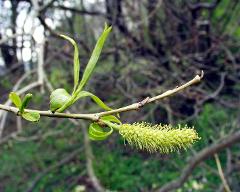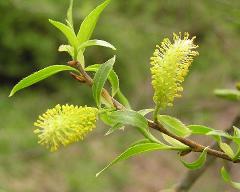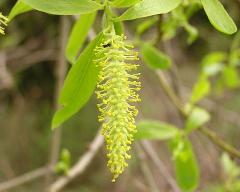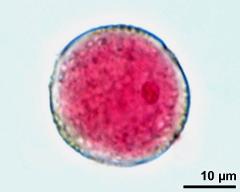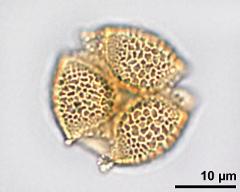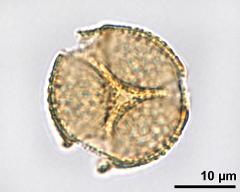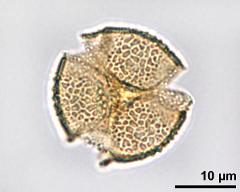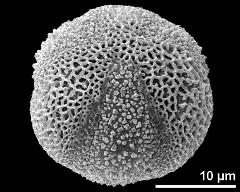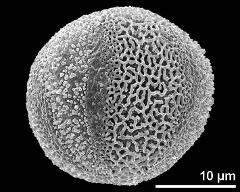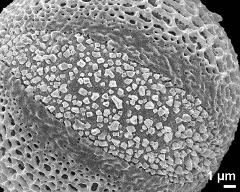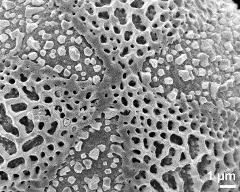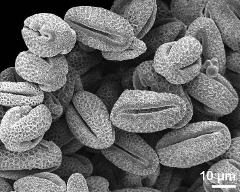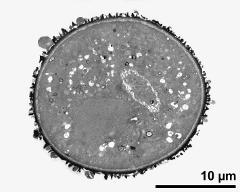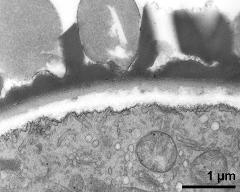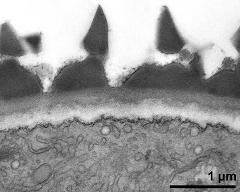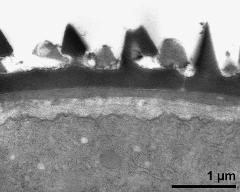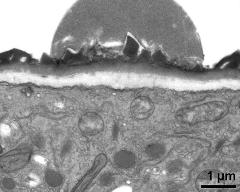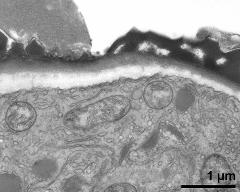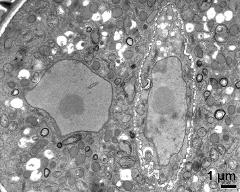Salix fragilis
Taxonomy: Angiospermae, Malpighiales, Salicaceae, Salix
Published: 2016-07-13
Pollen Description
Shape, Size and Aperture
pollen unit: monad, dispersal unit and peculiarities: monad, size (pollen unit): small (10-25 µm), size of hydrated pollen (LM): -, shortest polar axis in equatorial view (LM): -, longest polar axis in equatorial view (LM): -, shortest diameter in equatorial or polar view (LM): -, longest diameter in equatorial or polar view (LM): -, pollen class: colpate, polarity: isopolar, P/E-ratio: -, shape: spheroidal, outline in polar view: circular, dominant orientation (LM): -, P/E-ratio (dry pollen): prolate, shape (dry pollen): -, outline in polar view (dry pollen): lobate, infoldings (dry pollen): aperture(s) sunken, aperture number: 3, aperture type: colpus, aperture condition: colpate, tricolpate, aperture peculiarities: aperture membrane ornamented
Ornamentation and Structure
LM ornamentation LM: reticulate, heterobrochate, nexine: -, sexine: -, SEM ornamentation SEM: reticulate, heterobrochate, suprasculpture SEM: -, TEM tectum: semitectate, infratectum: columellate, foot layer: discontinuous, endexine: compact-continuous, intine: monolayered, wall peculiarities: -, supratectal element: -
Miscellaneous
pollen coatings: pollenkitt, reserves in cytoplasm: -, cell number: 2-celled, Ubisch bodies: absent
Author(s) of diagnosis: Halbritter, Heidemarie; Diethart, Bernadette
Pictures
Picture legend
- flower(s), photographer: Halbritter, H.
- male flowers, photographer: Diethart, B.
- male flowers, photographer: Diethart, B.
- pollen grain with generative cell - fresh, unfixed, aceto-carmine, photographer: Diethart, B.
- upper focus - fresh, acetolyzed, unstained, photographer: Diethart, B.
- optical section - fresh, acetolyzed, unstained, photographer: Diethart, B.
- lower focus - fresh, acetolyzed, unstained, photographer: Diethart, B.
- polar view - fresh, rehydrated (water) & critical point dried & sputter coated with gold, photographer: Halbritter, H.
- equatorial view - fresh, rehydrated (water) & critical point dried & sputter coated with gold, photographer: Halbritter, H.
- aperture - fresh, rehydrated (water) & critical point dried & sputter coated with gold, photographer: Halbritter, H.
- polar area - fresh, rehydrated (water) & critical point dried & sputter coated with gold, photographer: Halbritter, H.
- dry pollen grains - dry, sputter coated with gold, photographer: Halbritter, H.
- pollen grain in cross section - fresh, glutaraldehyde & osmium & potassium ferrocyanide, uranyl acetate & lead citrate, photographer: Diethart, B.
- interapertural area of pollen wall - fresh, glutaraldehyde & osmium & potassium ferrocyanide, modified Thiéry-test, photographer: Diethart, B.
- interapertural area of pollen wall - fresh, glutaraldehyde & osmium & potassium ferrocyanide, modified Thiéry-test, photographer: Diethart, B.
- interapertural area of pollen wall - fresh, glutaraldehyde & osmium & potassium ferrocyanide, uranyl acetate & lead citrate, photographer: Diethart, B.
- apertural area of pollen wall - fresh, glutaraldehyde & osmium & potassium ferrocyanide, modified Thiéry-test, photographer: Diethart, B.
- pollen wall at transition of aperture and interapertural area - fresh, glutaraldehyde & osmium & potassium ferrocyanide, modified Thiéry-test, photographer: Diethart, B.
- vegetative nucleus and generative cell (right) - fresh, glutaraldehyde & osmium & potassium ferrocyanide, modified Thiéry-test, photographer: Diethart, B.
Literature
- (1978) Entomophily in Salix: theoretical considerations. In: Richards A.J. (ed) The Pollination of Flowers by Insects. Linnean Society Symposium Series No 6 : 47-50
- (1967) Sporoderm in Populus and Salix. Grana Palynol 7: 517-567
- (1982) Entomophily in Salix. II. Efficacy and flower constancy of insects visiting some willows and sallows. Beitr Biol Pflanzen 56: 105-116
- (1994) Exkursionsflora von Österreich : 1180
- (1998) Preparing living pollen material for scanning electron microscopy using 2,2-dimethoxypropane (DMP) and criticalpoint drying. Biotechnic Histochem 73: 137–143
Copyright and Citation
Cite this publication as:
Halbritter H., Diethart B. 2016. Salix fragilis. In: PalDat - A palynological database. https://pc8.botanik.univie.ac.at/pub/Salix_fragilis/301226; accessed 2025-01-25

